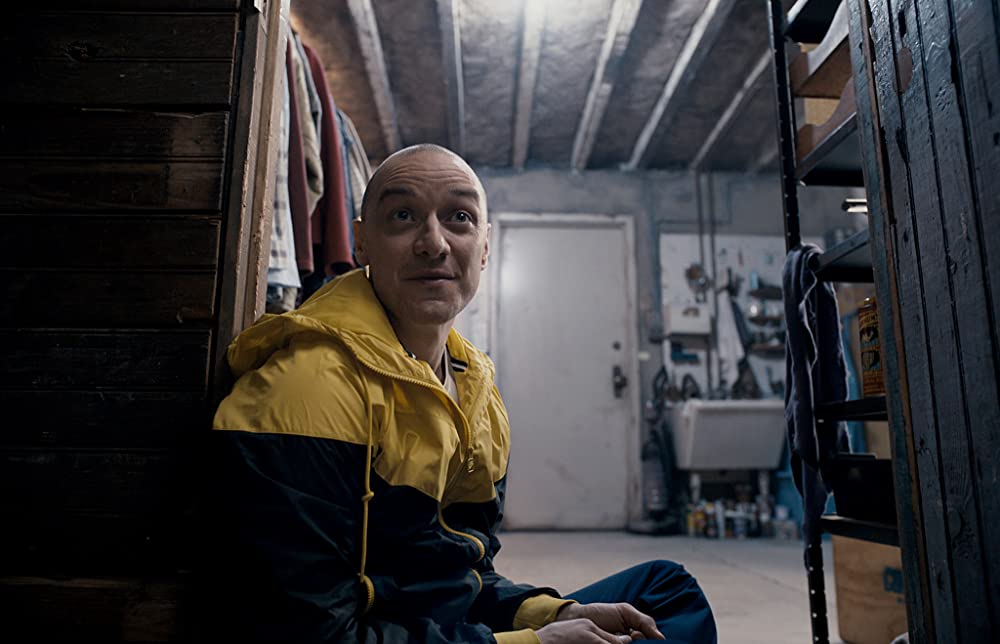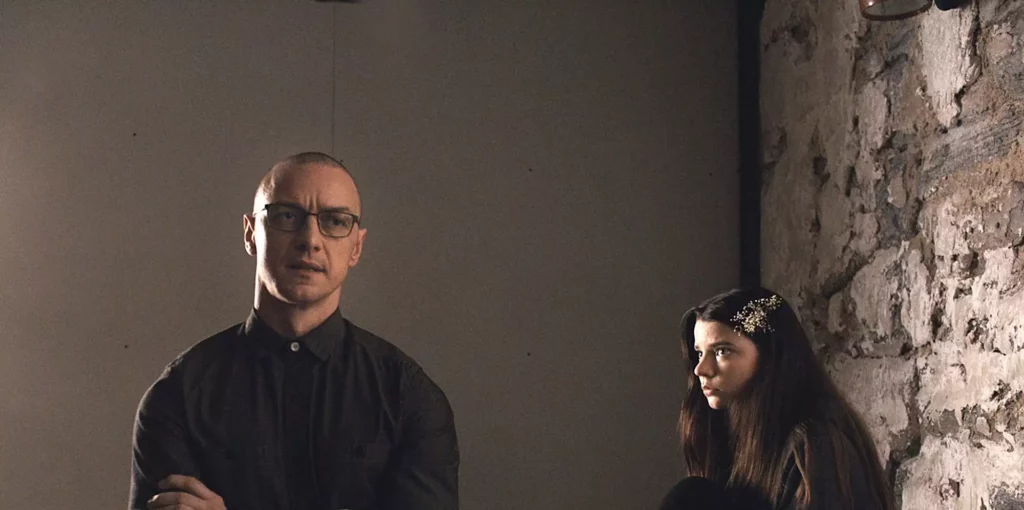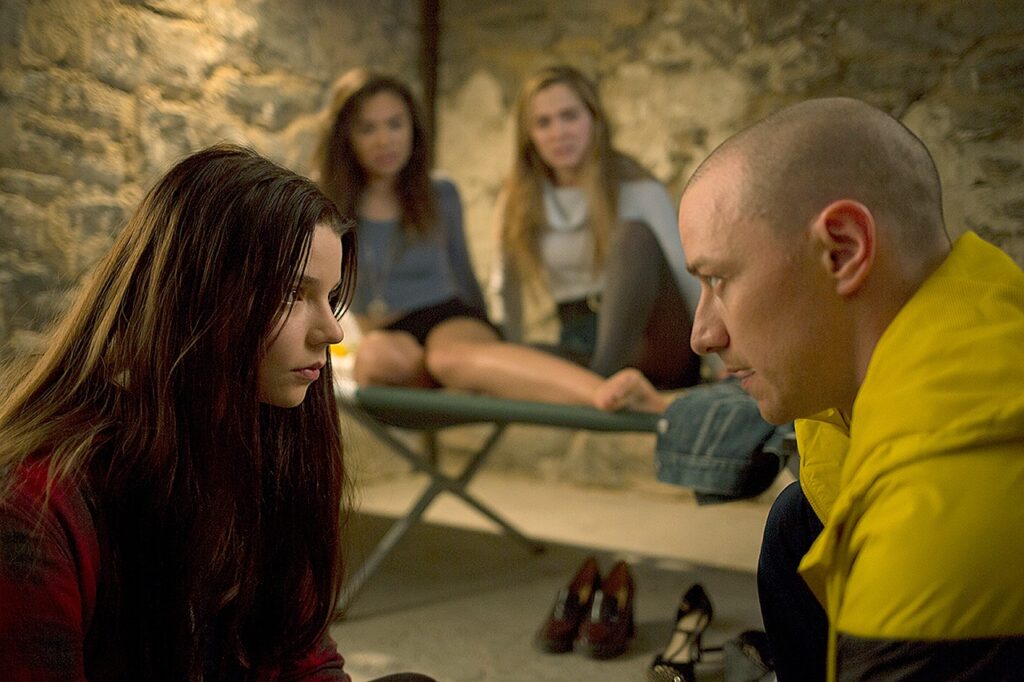McAvoy approaches the superpowered Kevin Wendell Crumb, and his alters with care and empathy, overcoming sketchy psychology.
Old tropes never die; they just fade away, and most not a minute too soon. Among the well-trod movie and T.V. plot devices that have been retired in the past decade is the “split personality,” a favorite of mystery and horror, in which a character has a hidden “evil” side that commits nefarious deeds, usually without the “good” side’s knowledge. Though its roots can be found in Robert Louis Stevenson’s The Strange Case of Dr. Jekyll and Mr. Hyde, its popularity peaked from the 70s well into the 90s, thanks mainly to Florence Rheta Schreiber’s Sybil, purportedly a true account of a woman’s struggle with split personality disorder, later called multiple personality disorder and now referred to as dissociative identity disorder, or D.I.D. for short.
Despite the fact that the events of Sybil were later determined to be embellished (if not made up entirely), it was adapted into a hit T.V. movie with Sally Field, and dozens of other movies and T.V. shows about split personalities, some also purporting to be “true stories” and some not, followed in its wake. It so often came up as a plot point that one would assume it’s a common personality disorder when, in fact, it’s the least common, affecting less than 2% of the population of North America and Europe combined. Most people will go their entire lives without encountering someone with D.I.D. Even today, precious little is understood about it. What is certain is that, contrary to popular belief, it doesn’t cause someone to have a “bad” personality that violently acts out. It’s an extreme reaction by the brain to severe childhood trauma, allowing a person to essentially “hide” behind a different persona as protection.
The announcement that M. Night Shyamalan’s Split would dip again from the well of tired (if not actively harmful) stereotypes about D.I.D. was met with derisive grumbles. Though he rebounded a bit with the surprise hit The Visit, Shyamalan was still smarting from the triple flops of Lady in the Water, The Last Airbender, and After Earth. It seemed a reckless choice even on the surface, and that was before anyone knew what the movie was actually about. Split not only revived the “bad side” trope that’s so pervasive in D.I.D. but depicted it as a literal monster, a sort of evil Hulk who designates people as “pure” and “impure” and kills and eats the impure ones. Knowing that it’s a secret (so secret it’s not revealed until literally the last minute of the film) sequel to Unbreakable helps to make it clear that Split is not attempting to be a reflection of reality.

Being a supervillain story keeps Split from crossing the line into offensive territory. What makes it watchable is James McAvoy, who, rather than play his role broadly, as if mocking the concept of D.I.D. (which the movie seems like it might be doing, albeit probably unintentionally), brings depth, soul, and a surprising amount of empathy to it.
McAvoy is Kevin Wendell Crumb – a perfect name for someone who’s essentially nothing, a speck drowned out by the other personalities in his mind. We don’t know much about Kevin except that he’s a child abuse survivor, works at the Philadelphia Zoo, and is mentally ill. He has D.I.D., juggling 23 distinct personalities in his broken brain. Most personalities, such as the fashion-conscious Barry and the mischievous child Hedwig, are harmless, even friendly and personable. Others, including the Norman Bates-like Dennis and Patricia, a middle-aged woman who speaks in a crisp English accent, are a bit more dangerous.
It’s Dennis who kidnaps teenager Casey Cooke (Anya Taylor-Joy) and two of her classmates, Claire (Haley Lu Richardson) and Marcia (Jessica Sula), holding them captive in his labyrinthian living space under the zoo. He can barely keep himself together in their presence, nearly swooning at the sight of a shirtless, distraught Claire and telling her, “I’m trying to be good,” in a voice that suggests it’s a losing battle.
Occasionally, the prim and proper Patricia must step in to ensure things don’t get out of hand. She looks after the girls, trying to keep them calm and cooking for them. However, her maternal nature should not be mistaken as kindness – she’s preparing the girls for the arrival of the Beast, a previously unrevealed 24th personality that’s something beyond human.

Not entirely understanding what’s happening but terrified of it all the same, the other personalities reach out for help to their psychiatrist, Dr. Fletcher (Betty Buckley), while fighting with Dennis and Patricia for dominance. Dr. Fletcher takes a special interest in Kevin not only because she cares about him (and she might be the only person who does) but because she believes that people with D.I.D. might be superhuman, with an unexplored ability that allows their bodies to physically adapt to whatever personality they happen to be exhibiting at a given time.
Now, there is a slight amount of real-life research to back this up—patients with D.I.D. experience changes in the limbic system, the part of our brains that controls behavior and emotional response. Here, it’s taken to much more elaborate lengths: Kevin as himself is slight and meek, but the Beast is practically a shaved gorilla, grunting and snorting, able to climb up walls like Spider-Man, strong enough to bend steel bars, and able to take a shotgun blast to the chest without flinching. It’s silly and inconsistent: if Kevin changes at a seemingly molecular level between each personality (such as one having diabetes while the others don’t, Dennis apparently needing glasses to see, etc.), why doesn’t he grow hair? Why doesn’t Patricia have breasts? Why isn’t Hedwig, a child, smaller than the others? Shyamalan’s script suggests that people with D.I.D. are essentially shapeshifters but doesn’t go all the way with it.

It’s a small miracle that McAvoy manages to make all this work somehow. His best moments in Split are not when he’s in literal Beast mode but in the quieter scenes with Buckley (also excellent) as Dr. Fletcher. Kevin’s personalities are now playing a game, impersonating each other to throw off Dr. Fletcher, who already knows that something’s wrong, but she doesn’t fall for it. A scene in which she gently but persistently coaxes out that Dennis is pretending to be Barry is excruciatingly tense, without restoring to the antics of the over-the-top third act. McAvoy’s performance is most effective during the subtle changes in his body language as he shifts from one personality to the next, even though that’s not how D.I.D. actually works.
Split’s most poignant moment is near the end after the Beast has been unleashed and killed Dr. Fletcher, Claire, and Marcia. Casey, an abuse survivor herself, is able to call forth Kevin as his actual self, the first time he’s been aware of anything in a painfully long while. Disoriented and frightened, he’s horrified at the sight of Dr. Fletcher’s body and begs Casey to kill him. It’s a brief reminder that whether you believe Kevin is a monster or a superhuman, there’s still a person in there who never asked for any of this, who’s suffering, scared, and now, with Dr. Fletcher gone, utterly alone in the world. A character that could easily be portrayed as cartoonish instead is granted some compassion. Kevin Wendell Crumb didn’t deserve what happened to him, and now it’s everybody’s problem.